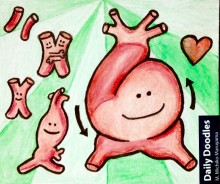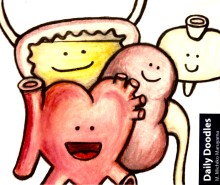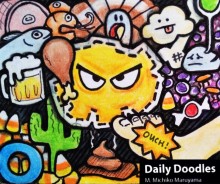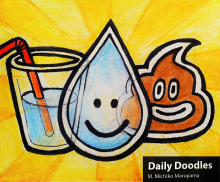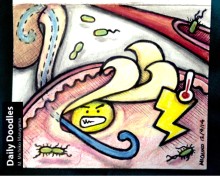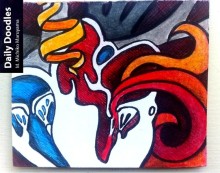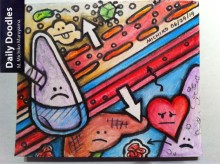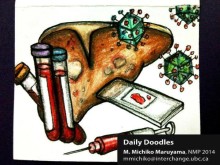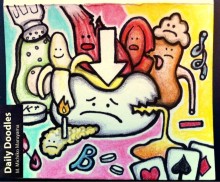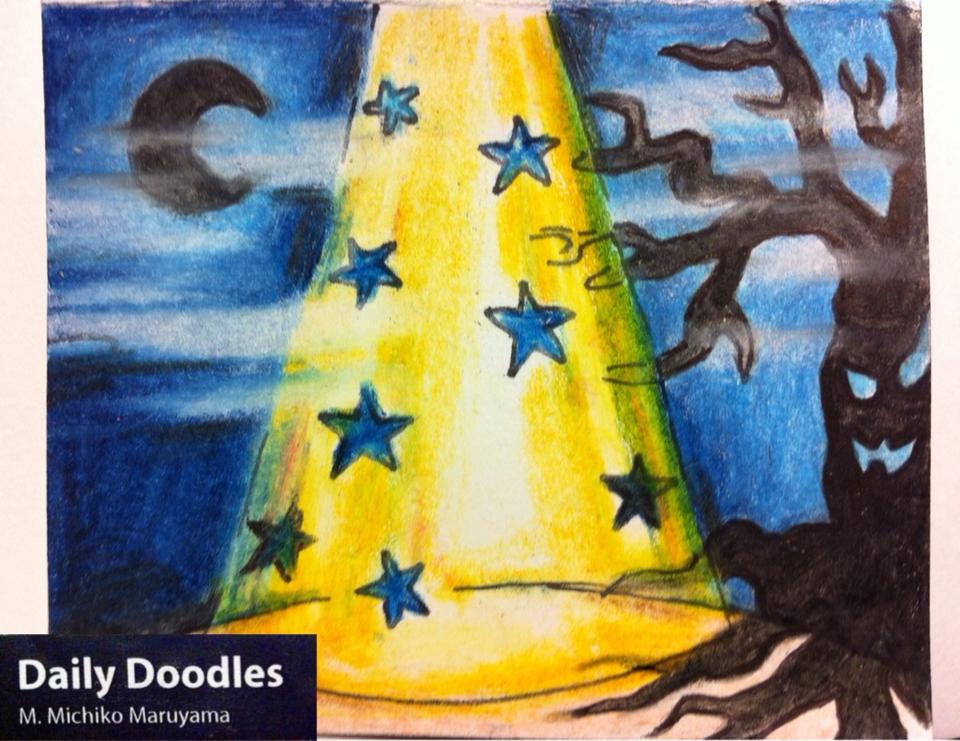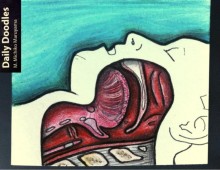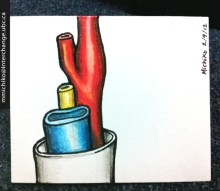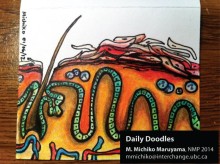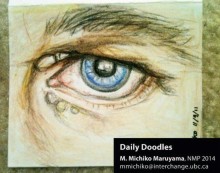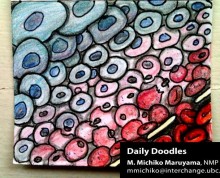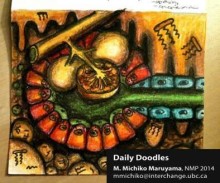Myocardial infarctions can be classified into various types based on pathology, clinical presentation, prognostic and treatment strategies. One method of classifying MI’s is the “Third Universal Classification of Myocardial Infarction”: Type 1 – Spontaneous MI: (top left corner) related to… Read more ›
This Daily Doodle illustrates the anatomical position of the left kidney, which is located approximately 1 cm higher than the right kidney. I originally intended to illustrate the surface anatomy, however I did not want to subdue the colors by adding… Read more ›
This Daily Doodle features the embryology of the heart, one of my favorite organs! The cardiovascular system is the first major system to function in the developing embryo. In the third week of development, the primodial heart and vascular system… Read more ›
This Daily Doodle marks an exciting moment in my life that I am so honored to be a part of – The Canada Winter Games Torch Relay 2015. Several years ago, I participated in the Canada Winter Games in Newfoundland… Read more ›
To start off my Gross Anatomy Elective, I will begin with a review of embryology because I love embryology! It is like origami but with organs which inspired me to start my “Organami” project. This Daily Doodle illustrates the embryology… Read more ›
This Daily Doodle marks the start of my fourth year Gross Anatomy Elective! This elective is designed to give medical students time and opportunity to explore and review cadaver based gross anatomy, perfect for students interested in surgical disciplines with a… Read more ›
This Daily Doodle illustrates non-obstructive acute pyelonephritis, an acute inflammation of the kidney and renal pelvis, typically caused by bacterial invasion of the renal parenchyma. As depicted in this doodle, clinical presentation involves fever, flank pain (lightning bolt), nausea and… Read more ›
This Daily Doodle illustrates Pityriasis Versicolor (aka tinea versicolor), a superficial cutaneous fungal infection that typically presents as numerous irregularly well demarcated macules of hypopigmented or hyperpigmented skin on the chest, back or proximal extremities. These macules can enlarge and… Read more ›
This Daily Doodle is a collage of the pathogenesis and clinical presentation of Ebola Virus Disease. As described on the Government of Canada Ebola Website Page [1]: “Ebola virus disease (EVD) is a severe disease that causes hemorrhagic fever in… Read more ›
Uric acid is the product of the metabolic breakdown of purine nucleotides. It is composed of carbon, nitrogen, oxygen, and hydrogen. In the United States and Europe, 5-10% of urinary tract stones are uric acid stones [1]. This percentage increases… Read more ›
This Pediatric Urology Daily Doodle illustrates the “3 Secrets of Life” to maintaining a healthy and happy bladder. The first secret – drinking plenty of fluids. Water is best. How much? Enough to create clear and colourless urine, so it… Read more ›
This Daily Doodle illustrates a Boxer’s Fracture, a fracture across the distal neck of the fifth metacarpal bone. Boxer’s fractures account for ~10% of all hand fractures. Mechanism of injury: “Direct trauma to a clenched fist, such as punching a… Read more ›
Treatment of calculi depends on several factors, including size, location and composition of the stones as well as the patient’s clinical presentation. This Daily Doodle illustrates an angry septic stone, sitting at the UVJ (ureterovesical junction – where the ureter meets the… Read more ›
This Daily Doodle illustrates the differential diagnosis of hematuria. A popular mnemonic = “TICS”: T Trauma: trauma, foley insertion, foreign body, extensive exercise Tumor: kidney, bladder, prostatic and urethral neoplasms Toxins: turpentine, phenols, sulfonamides, cyclophosphamide, NSAIDs I Infections: cystitis, prostatitis, urethritis, TB… Read more ›
This Daily Doodle is an abstract illustration of Hypertrophic Cardiomyopathy (HCM), a disease of the myocardium (heart muscle). The hallmark of this condition is asymmetrical myocardial hypertrophy (thickening), typically of the left ventricle and often the interventricular septum. This thickening… Read more ›
During a lecture in my second year of medical school, we had an interactive panel discussion on the many actions of testosterone which included a discussion on anabolic steroids abuse. This Daily Doodle illustrates the adverse effects of anabolic steroid abuse… Read more ›
Meet Staphylococcus aureus. Although these cute appearing cocci form cuddly grape-like-clusters on agar culture slides, watch out! Take caution with these gram positive creatures because they can cause many types of infections by creeping through cracks in the skin or mucosal… Read more ›
A young man was admitted for chest pain. He underwent several investigations which showed early signs of coronary artery disease. Upon discharge, the doctor asks “What is the most important thing you can do to stop future heart attacks?” “Rest!” –… Read more ›
Pleural effusion is a condition in which excess fluid accumulates in the pleural cavity. Typically, the pleural cavity is filled with a small amount of pleural fluid, however, the pleural cavity has the potential of accumulating large amounts of fluid.… Read more ›
The heart is contained in a beautiful dual layered fibroserous elastic sac called the pericardium. The outer layer, the fibrous pericardium, is made of a tough connective tissue while the inner layer, the serous pericardium, is thin and consists of… Read more ›
Inspired by Canadian Astronaut Colonel Chris Hadfield, this Daily Doodle captures a moment that I will never forget. It was the evening of the Dr. Bob Ewert Memorial Lecture and Dinner in Prince George, British Columbia, and Col. Chris Hadfield was… Read more ›
Inspired by the artwork of Frank Netter and my experiences in the gross anatomy lab, this Daily Doodle highlights the anatomy and vasculature of the Left Kidney, which is one of the unique areas of asymmetry in the body. The… Read more ›
Inspired by the beautiful anatomical lithograph drawings from Gray’s Anatomy, this Daily Doodle illustrates the difference between direct and indirect inguinal hernias. The perspective of this drawing is looking at the transversalis fascia from inside the abdomen. Try to imagine… Read more ›
“Derived from the Greek words “sclerosis” meaning hardness and “derma” meaning skin, scleroderma literally means hard-skin” [2]. But, with that said, scleroderma can affect more than just the skin! Scleroderma is a chronic and progressive connective tissue disorder caused by… Read more ›
This Daily Doodle represents the differential diagnosis of “chest” pain/discomfort which is quite an extensive list of both cardiac and non-cardiac conditions. In the ER, the initial approach to chest pain is to rule out potentially life-threatening causes, the big… Read more ›
The term hepatitis refers to inflammation of the liver. From toxins to infections, the differential diagnosis is quite broad, however, much can be learned from history which can narrow down the differential. Recent travel, medication overdose, history of alcoholism, IV… Read more ›
Day 1 of Surgery Clerkship Rotation: This Daily Doodle highlights the anatomy seen during a laparascopic cholecystectomy and contains a few other knowledge goodies, including Calot’s Triangle and Charcot Triad. I have read a few different variations of Calot’s Triangle,… Read more ›
Blue = Schwann cell, pink = nucleus of Schwann cell, yellow = axon of a peripheral nerve Schwann cells are the main supporting cells (glia cells) of the Peripheral Nervous System. Similar to the oligodendrocytes in the CNS, the purpose of… Read more ›
The appendix is a blind ended tube like structure connected to the cecum near the ileocecal valve. The most common location of the appendix is approximated by McBurney’s point, a point over the lower right quadrant of the abdomen located… Read more ›
This Daily Doodle illustrates two different conditions: adenomyosis and struma ovarii. To note, there is no link between the two – I just wanted to include both cases on one doodle. Adenomyosis is a condition when the endometrium (inner lining… Read more ›
This Daily Doodle acts as a simple visual reminder of the steps involved in the primary survey of a trauma patient. Remember your ABCs (plus D and E). Quick overview: A – Airway with Cervical Spine Control: Assume cervical spine… Read more ›
Giardia lamblia (aka: G. duodenalis or G. intestinalis) Don’t be tricked by these cute looking flagellated protozoans! They are often up to mischief, causing acute or chronic diarrhea with greasy foul-smelling stools, increased flatulence, abdominal pain, bloating, nausea and less… Read more ›
Embryology! One of my favorite topics. I am absolutely fascinated about how the body grows, folds and divides during the course of development! The way I approach embryology of an organ is to start with a simple tube and to… Read more ›
The normal concentration of serum potassium is 3.5 – 5.0 mEq/L. When potassium levels climb above the normal limits (>5.0 mEq / L), it is termed Hyperkalemia. This Daily Doodle captures some of the causes of Hyperkalemia which can be… Read more ›
Lectures: Intro to the Integument Block, Language of Dermatology, Common Infections of the Skin, Pre-Lab Orientation, Skin Histology Lab, Physiology of the Skin Skin! One of my favorite organs. It protects us from mechanical and chemical insults, micro-organisms and UV… Read more ›
This daily doodle focuses on Acne Vulgaris, an inflammatory condition of the pilosebaceous unit that is associated with the formation of “comedones” (plugged hair follicles). There are two main types of comedones: 1. Closed = white head 2. Open = black head Contrary to the… Read more ›
Introduction to Hematologic Malignancy During this lecture, we learned how to approach Hematologic Malignancy, with the focus on 5 major diseases: leukemia, lymphoma, myeloproliferative disorder (MPD), myelodysplastic syndrome (MDS) and multiple myeloma. The approach begins with asking three questions: 1.… Read more ›
This Daily Doodle is in support of Alberta local pharmacies and local pharmacists across Canada. When I was undergoing treatments at the Cross Cancer Institute in Edmonton, my mentor would pick me up each week to take me to “his… Read more ›
Takotsubo Syndrome, also known as Stress-induced cardiomyopathy, Broken Heart Syndrome and Transient Apical Ballooning Syndrome, is a type of non-ischaemic cardiomyopathy characterized by transient systolic dysfunction of the apical and/or mid-segments of the left ventricle that mimics myocardial infarction. The… Read more ›
Today, while I was waiting for my treatment, someone asked me “What do you think about when you are lying in the machine and getting radiation?” “I think about PAC-MAN.” “…PAC-MAN?” “Yes, PAC-MAN, that hungry yellow disc.” I imagine that my… Read more ›
After being diagnosed with cancer or any disease or illness, a common first reaction is to start taking as many vitamins and herbal remedies as possible – load up on Vitamin X, Y and Z and start drinking herbal tea.… Read more ›
First Day of Radiation! This Daily Doodle marks my first day of radiation. I met with my radiation oncologist to go over the treatment plan which was followed by my first round of radiation. Afterwards, I went to a group… Read more ›
Last night, I couldn’t sleep. I laid awake, palpating a new area that felt like tumor, trying to remember whether it was in the radiation field or not. Is there a new tumor lurking just beyond the borders of the… Read more ›
“As doctors [and medical students], we have to ask the standard questions, “Have you noticed any unexplained changes in weight? Have you felt fatigued or tired lately?…” Sometimes, we have to ask more personal questions, “Have you experienced any changes… Read more ›
I Feel Like a Giant Chicken. This Daily Doodle captures how I felt in the midst of my egg harvesting procedure. Every day, I would inject myself with hormones and every few days, I would have an ultrasound to monitor… Read more ›
Today, I started yet another new drug called Letrozole. This Daily Doodle features its chemical structure and the mechanism of action. Letrozole is a non steroidal aromatase inhibitor which essentially decreases the amount of estrogen in the body. It is typically… Read more ›
This Daily Doodle accompanied my facebook status I posted over a month ago – I was walking along the seawall and a man who passed me said, “If you walk any slower, you would be going backwards”… Sigh… Do I… Read more ›
First Day of Medical Leave. This Daily Doodle marks the first day of my medical leave. My goal is to keep up with my daily doodles during my treatment because each day, I learn something new as a patient. At… Read more ›
This Daily Doodle represents the medical uses of the powerful neurotoxin produced by Clostridium botulinum and it also serves as a review of the intricate anatomy of the facial muscles. Clostridium botulinum is a obligate anaerobe, spore-forming, gram-positive, rod-shaped bacteria… Read more ›
In order to remember all the different medications in my ER rotation, Blake and I started to create one liner jingles. This is one of my favorites – “If your tooth abscess is a killin’, use amoxicillin!” Amoxicillin is a… Read more ›
This Daily Doodle represents the academic half day lecture on Biliary Disease. The gallbladder, which is surprisingly green, collects and stores bile produced by the liver. Bile is used to emulsify fat and aids in the digestion of lipids in… Read more ›
Shock = inadequate organ and tissue perfusion with oxygenated blood. This doodle captures the four main categories of shock: 1. Hypovolemic Shock: – Hemorrhage – Severe burns – Dehydration 2. Cardiogenic Shock – MI – CHF 3. Obstructive Shock –… Read more ›
Septic 7 This Daily Doodle captures the 7 signs of septic shock 1. Sepsis (+ blood culture) 2. WBC – elevated >12000 cells or < 4000 cells 3. Hypotension 4. Tachycardia – fast beating heart 5. Tachypnea – lots of… Read more ›
This Daily Doodle represent one of my favorite Academic Half Day Seminars on Airway Management. During this seminar, we learned and practised the basics of airway management including intubation. I was so amazed by the simulation lab at the University… Read more ›
Ovarian Cancer is the 5th most common cancer in women and the most common cause of death from gynecologic cancers. There are many different types of ovarian tumors, however, 90% are derived from epithelial cells. Unfortunately, symptoms of early stage… Read more ›
The layer of cells that line the uterus is called the endometrium (red). It is this layer that proliferates in response to estrogen and later, develops into a secretory lining in response to progesterone. If implantation of a fertilized egg… Read more ›
Three of my favorite cells in the body: osteoblasts, osteocytes and osteoclasts. This trio of cells play a key role in bone modeling and remodeling. Your bones are dynamic structures in your body. They are constantly changing, adapting to stress,… Read more ›
This Daily Doodle represents depression and it is inspired by an illustration published in JAMA on Bipolar Disorder, which I featured in an earlier doodle (Feb 22, 2012). Unlike Bipolar Disorder, depression does not have the elevated state of mania.… Read more ›
In today’s lecture and gross anatomy lab, we learned about the various bones, muscles, vessels and nerves of the neck. This Daily Doodle shows the contents that are encapsulated by the carotid sheath, a thick tube of connective tissue (gray).… Read more ›
This Daily Doodle features the Homunculus of the Primary Motor Cortex. The primary motor cortex is a strip of the brain that is responsible for body movement. It is located anterior to the central sulcus, a prominent landmark that separates… Read more ›
Today, we moved on up from the brain stem to the cerebral cortex. We learned about the various functional areas of the cortex and the symptoms created by different lesions. This Daily Doodle represents a syndrome caused by a lesion… Read more ›
This Daily Doodle captures the first time I saw an optic disc using an ophthalmoscope! The optic disc is located on the back of the retina and it is where the axons gather and exit the eye, forming the optic… Read more ›
During today’s lecture, we covered several common Inflammatory skin disorders, including: Psoriasis, Atopic Dermatitis, Seborrheic Dermatitis, Pityriasis Rosea and Lichen Planus. This daily doodle highlights the key pathologic features of Psoriasis, which include: – Elongated rete ridges (epidermal hyperplasia) –… Read more ›
Today is World Diabetes Day, represented by the blue ring symbol. This daily doodle features the three main tissues involved in carbohydrate metabolism: hepatocytes (liver cells), adipocytes (fat cells) and muscle. The blue ring also represents insulin, one of the… Read more ›
This daily doodle highlights some of the physical signs seen in hypercholesterolemia conditions, such as Familial Hypercholesterolemia. When cholesterol levels are high, they can deposit in various places in the body, including around the eyes which is termed xanthelasma palpebrarum.… Read more ›
First day of Endocrine! This daily doodle features a VLDL, one of the five major groups of lipoproteins (chylomicrons, very-low-density lipoprotein, low-density lipoprotein, intermediate-density lipoprotein and high-density lipoprotein). VLDLs are assembled in the liver from endogenous triglycerides, cholesterol, and apolipoproteins (white… Read more ›
A healthy platter of food for your bones! Salmon packed with Vitamin D (but not as much as what you get from the sun!), calcium loaded with milk and cheese, delicious cheese! Don’t forget your fruits, vegetables and nuts! In… Read more ›
Today, we had an orientation on breast and pelvic exams to prepare us for our clinical skills sessions next week. It was a very helpful and interesting session. This doodle is of a demonstration model that we used to learn… Read more ›
This daily doodle captures all, well, most, of the blood cellular components which are all derived from the main haematopoietic stem cells found in bone marrow (top left). Included in this Haematopoietic Family Photos are eosinophils, basophils, neutrophils, red blood… Read more ›
This daily doodle represents the development of the Red Blood Cell in the bone marrow. This process is called Erythropoiesis and it is stimulated by decreased oxygen in the circulation, which is detected in your Kidneys. In response to low… Read more ›
The two main Inflammatory Bowel Diseases (IBD) include Crohn’s Disease and Ulcerative colitis. Although they are both grouped as inflammatory bowel diseases, there are significant differences between the two. This daily doodle tries to illustrate these differences. The top half… Read more ›
Pathology of the Upper GI, Malabsorption Syndromes and Introduction to GI Clinical Skills. This daily doodle features Helicobacter pylori, a perforated gastric ulcer (OUCH!) and a little bit of Barrett’s esophagus. I just realized that this composition makes it look… Read more ›
This doodle is a collage of the many things that I learned today, from the functional unit of the pancreas, which contains acinar (red) and duct cells (blue) to the emulsification of fat (oil with triglycerides dripping down and turning… Read more ›
In lecture, we covered the physiology of Gastric Secretion and Peptic Ulcer Disease. Here is the upper gastrointestinal mucosa, which is covered by a layer of mucus (orange). The surface mucous cells (green) releases bicarbonate into the mucus which neutralizes… Read more ›
Embryology of Foregut and review of GI Gross Anatomy. During the embryology lecture, we went over the development of the foregut derivatives, which include: upper respiratory system, lower respiratory system, esophagus, stomach, liver, pancreas, gallbladder and the proximal part of… Read more ›
First day of 2nd year! The GI block started off with an overview of the GI tract histology and then a lecture on neuromuscular control of gut motility. This doodle represents the different layers of the GI tract that we… Read more ›
This Daily Doodle features two themes – injections and metastasis of cancer. During our Needle Workshop, we learned how to draw up and administer intramuscular and subcutaneous injections. Our test subjects – oranges and tomatoes, which is why there is… Read more ›




